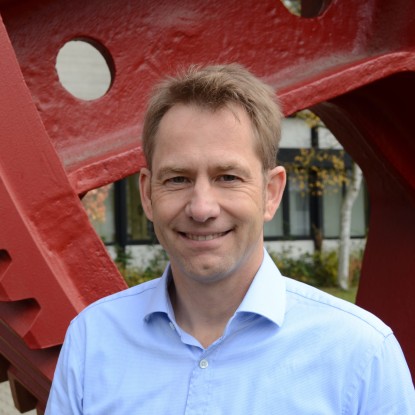Team
| Name | Contact | |
|---|---|---|

| Prof. Dr.-Ing. Christian Hasse | hasse@stfs.tu-... +49 6151 16-24142 L1|01 281 |

| Jannis Reusch M.Sc. | reusch@stfs.tu-... +49 6151 16-24148 L1|01 289 |

| Roberto Lange M.Sc. | lange@stfs.tu-... |
Motivation
To reduce the NOx in diesel IC engines, selective catalytic reduction (SCR) system is a widely adopted methodology. Thereby, with the help of available heat from exhaust gas, the urea–water solution (UWS) injected into the exhaust pipe is intended to turn inside the exhaust port into gaseous ammonia (NH3) by evaporation of mixture and thermal decomposition. Depending on the engine load and exhaust gas conditions, the urea injection, the thermal decomposition and the associated formation of solid by-products or deposits affect strongly the overall SCR system efficiency.
Generally, a SCR system can be subdivided in two intentionally parts. The first region includes the domain where UWS is injected, and the ammonia is formed and mixed with the exhaust gas. The second represents the actual SCR catalyst where NOx is finally removed by taking advantage of heterogeneous chemical reactions within the monolith.
Up to now, the complex multi-physics and multiscale phenomena associated with SCR system, especially the aggregation of urea after evaporation of water and during the thermal decomposition of urea in the SCR duct and monolith channels has not been fully understood.
Objectives
In the previous study, a detailed droplet evaporation and urea decomposition model was developed, subsequently models for adBlue injection and spray break-up evolution were integrated. The objectives of the present subprojectl within this research period consist in the: (i) development of a transported filtered-density-function (T-PDF) methodology that will enable to describe correctly the evolving turbulence/chemistry/particle interaction, (ii) integration of urea reaction kinetics which includes by-product and deposit formation, (III) analysis of the influence of heat and mass transfer processes on flow in the honeycomb monolith channels, (IV) entropy based analysis of irreversible processes occurring in the SCR system, (V) investigation of the wall-film and deposit formation upstream and inside the monolith, (VI) evaluation of the predictive capability of the suggested complete model.
Approach
In order to develop a reliably predictive simulation tool for such a complex SCR system in which transient adBlue injections (see Fig.1a) and subsequent formation of highly heterogeneous ammonia mixture (see Fig.1b) take place, an accurate description of the turbulence/chemistry/particles interaction in addition to the phase change process along with near wall reacting multi-phase flow phenomena is indispensable. Since this requires a multi-dimensional formulation, a transported filtered-density-function (T-FDF) approach is employed in order to consider properly both the urea surface reaction kinetics, the effects of the vaporizing particulate phase and its coupling with a Lagrangian-based spray model along with the liquid wall-film and deposit formation models.
To make possible a valuable characterization of local irreversibilities in SCR systems, an entropy based analysis will be carried out. For that purpose the second law of thermodynamics will be introduced in the context of large eddy simulations (LES). Non-closed terms in the resulting filtered entropy inequality will be postulated for mass, momentum and energy transfer processes as well as for chemical reactions and phase change phenomena while thermodynamically consistent subgrid-scale (SGS) models will be formulated and integrated.
Finally, the predictive capability of the suggested modelling tool will be appraised by comparison with experimental data from the CRC150.
A detailed droplet evaporation and urea decomposition model was developed which especially accounts for the species and thermal diffusion inside the droplet. Figure 2a demonstrates how this model including various urea decomposition mechanisms allows to retrieve the droplet evaporation process of single urea droplets.
Subsequently, a spray module was developed for the first time within a full LES framework based on an Eulerian–Lagrangian approach. It includes especially (1) a primary and a secondary breakup model along with an advanced collision model, both to account for the atomization generated close to the nozzle exit by the multi-hole circular orifice injector used and (2) a multi-component droplet evaporation model along with a two-way coupling between the carrier gaseous phase and the droplet liquid phase throughout the dilute spray region. The suggested model was applied to evaluate the dynamics of the multi-component droplets spray resulting from an adBlue injection into a hot gas cross flow inside a channel mimicking a SCR-DeNOx flow system as depicted in Figure 1a. Figure 2b shows the droplet size distribution profile for both the injected water and adBlue in comparison with PDA measurement data by Spiteri (PhD thesis, ETH, 2016).
Present work
The previous work is being extended by considering a transported-PDF method in order to accurately describe the turbulence/chemistry/particles interaction in addition to the phase change process along with near wall reacting multi-phase flow phenomena while including properly both the urea surface reaction kinetics and the coupling with a Lagrangian-based spray description.
The detailed reaction kinetics for urea including by-products and deposits formation provided by TP B05, and reduced in the framework of the so called REDIM (reaction-diffusion manifolds) method within the activities in TP B07 will be introduced. To retrieve the liquid wall-film evolution and deposits formation the models developed in TP B01 will integrated.
Due to incomplete thermolysis and hydrolysis the adBlue droplet can deposit on the SCR-monolith leading to reduction of its efficiency. Therefore, the impact of the multi-phase flow through the monolith channels will be investigated in more detail. In particular the effect of laminarization of the turbulent inflow within the channels on the ammonia transport and on the deposit formation will be highlighted.
Finally, the predictive capability of the complete model will be appraised by comparison with experimental data from TP C04 and A05. Thereby, systemic parametric studies will be performed in order to characterize the SCR system in terms of NH3 conversion and its degree of homogeneity as well as its subsequent impact on NOx reduction efficiency and ammonia-slip
Collaboration
This project is developing a LES-based predictive tool that will enable to carry out reliable detailed numerical analysis of a SCR system. Experimental data obtained from A05 and C05 will be used for model validation. To account for the turbulence/chemistry/particle interactions the Transported-PDF approach will consider detailed chemistry developed by C03 and reduced within the REDIM tabulation methodology by B07 (B05) for both gas and liquid phase reactions. The turbulent near-wall phenomena will be described also by using subgrid scale models developed by B03 (B02, A06N). In particular, the liquid wall-film evolution and deposits formation will be included by means of models which will be made available by B01, B08N.





